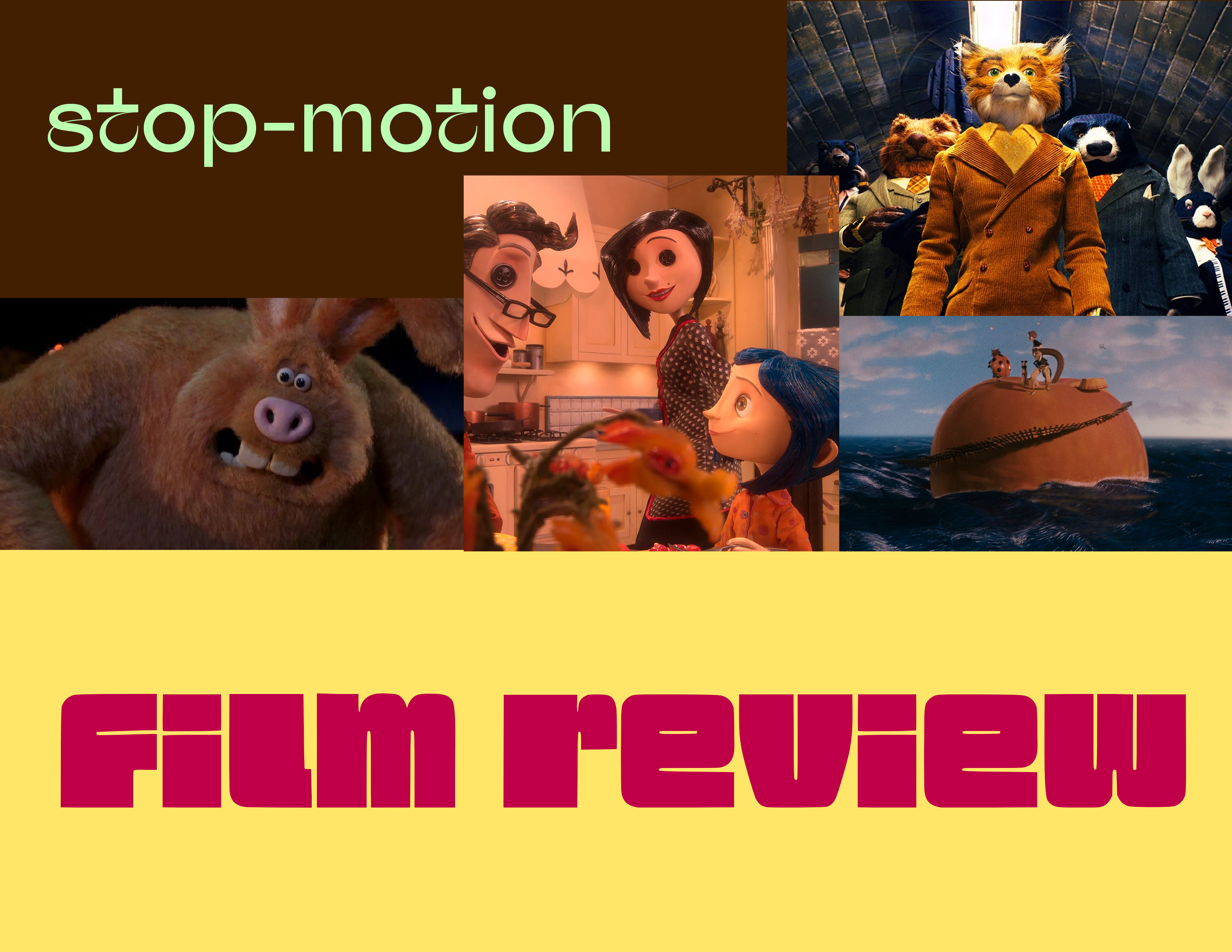
Fantastic Mr. Fox
Some artists have a way of riveting your vision with the certitude of what they do. This has nothing to do with subject or style. Its inexplicable. Andy Warhol and Grandma Moses. The spareness of Bergman or the Fellini circus. Wes Anderson is like that. There’s nothing consistent about his recent work but its ability to make me go zooinng! What else do “The Darjeeling Limited” and “The Life Aquatic with Steve Zissou” have in common?Now heres “Fantastic Mr. Fox,” an animated picture with nothing in common with traditional animation, except that it’s largely in one of the oldest animation styles of all — stop motion, the one used in “King Kong.” The animals aren’t smaller than people but often larger, and more mature.
They live in a sometimes flat dimension; the cameras are happier sliding back and forth than moving in and out. The effect is sometimes like a old-fashioned slide projector. The landscapes and structures of this world are mannered and picture-booky. Yet the extraordinary faces of the animals are almost disturbingly human (for animals, of course). We venture into the UnCanny Valley, that No Mans Land dividing humans from the devised. Above all, their fur is so real. I’ve rarely seen such texture in a film.
info:
Director: Wes AndersonStarring: George Clooney
Bill Murray
Meryl Streep
Release date:
November 13, 2009
Nor are the animals all saints. Mr. Fox, voiced by George Clooney, was a flourishing chicken thief until times grew risky. Then, like a bootlegger after the repeal, he went straight — or, more precisely, into journalism. Hes the Walter Winchell of the valley, until he slips back into dining on takeout chicken, taking them out himself. This he keeps a secret from the upright Mrs. Fox (Meryl Streep).
His deception is blown, to everyones great disappointment, when the fat, short and lean ones all turn into mean ones and declare war. Leading a team of other animals, Mr. Fox starts tunneling like the heroes of “The Great Escape” — but in, rather than out.These adventures provide the setting for personal drama, as an uncertainty arises between Mr. Foxs callow son, Ash (Jason Schwartzman), and a cousin named Kristofferson (Eric Anderson). Kristofferson is all a fox should be, as with that name how could he not? Hes the family golden child, or fox. Does Mr. Fox admire the cousin more than his son? What kind of pop has he been, anyway?
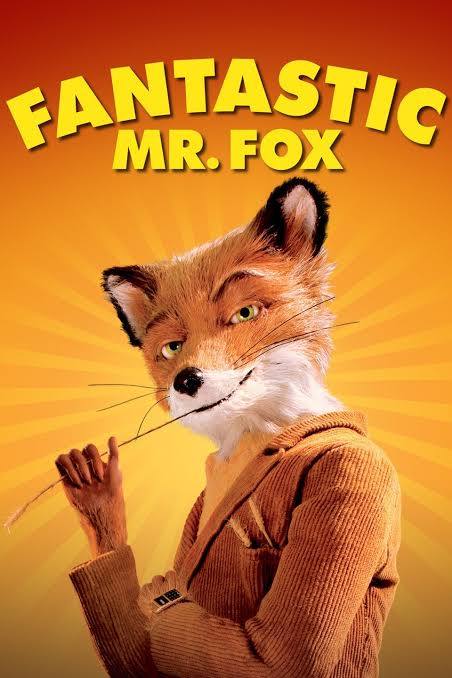 All of the animals have excellent tailoring, which adds to their stature. Theyre not forced to wear silly sailor suits, or like Donald Duck, never to put on pants. The art design is a large part of the films appeal. It stays fresh all the way through. Think back to the color palettes of “Darjeeling” and “The Life Aquatic.”
The films based on the famous childrens book by Roald Dahl, which like all of his work, has ominous undertones, as if evil can steal in at any moment. These animals arent catering to anyone in the audience. We get the feeling theyre intensely leading their own lives without slowing down for ours.
Like the hero of “Willy Wonka and the Chocolate Factory,” also based on one of his books, the creatures of Dahls valley seem to know more than they’re letting on; perhaps even secrets we dont much want to know. Children, especially, will find things they dont understand, and things that scare them. Excellent. A good story for children should suggest a hidden dimension, and that dimension of course is the lifetime still ahead of them. Six is a little early for a movie to suggest to kids that the case is closed. Oh, what if the kids start crying about words they don’t know? — Mommy, Mommy! What’s creme brulee?” Show them, for goodness sake. Theyll thank you for it. Take my word on this.
All of the animals have excellent tailoring, which adds to their stature. Theyre not forced to wear silly sailor suits, or like Donald Duck, never to put on pants. The art design is a large part of the films appeal. It stays fresh all the way through. Think back to the color palettes of “Darjeeling” and “The Life Aquatic.”
The films based on the famous childrens book by Roald Dahl, which like all of his work, has ominous undertones, as if evil can steal in at any moment. These animals arent catering to anyone in the audience. We get the feeling theyre intensely leading their own lives without slowing down for ours.
Like the hero of “Willy Wonka and the Chocolate Factory,” also based on one of his books, the creatures of Dahls valley seem to know more than they’re letting on; perhaps even secrets we dont much want to know. Children, especially, will find things they dont understand, and things that scare them. Excellent. A good story for children should suggest a hidden dimension, and that dimension of course is the lifetime still ahead of them. Six is a little early for a movie to suggest to kids that the case is closed. Oh, what if the kids start crying about words they don’t know? — Mommy, Mommy! What’s creme brulee?” Show them, for goodness sake. Theyll thank you for it. Take my word on this.
James and the Giant Peach
Almost all Disney animated films involve dead or absent parents whose departure frees their little heroes to become independent adventurers. But ”James and the Giant Peach” wipes out the parents with so much glee, it almost seems like an inside joke. The movie opens with a pastel, soft-focus live action sequence in which little James lives an idyllic life by the seaside with his loving mom and dad. All is perfect. And then–bam! Both parents are gobbled up by a giant rhinoceros. So much for them. James (Paul Terry) is immediately packed off to a miserable life with his horrid relatives, Aunt Sponge and Aunt Spiker, who work him like a slave, mock him and feed him fish heads–when he’s lucky. The lonely little boy draws his dreams on a paper bag and makes it into a hot-air balloon, sending it floating by candlepower.
info:
Director: Henry SelickStarring: Paul Terry
Joanna Lumley
Susan Sarandon
Release date:
April 12 1996
A mysterious old man (Pete Postlethwaite) finds the paper bag and returns it filled with countless little green crocodile tongues. James spills the bag, and some of the tongues hop away, but one enchants an old peach tree on the aunt’s property and a giant peach starts growing. His aunts sell tickets to the attraction, but then the starving James eats a bite of the peach, along with a crocodile tongue, and that unleashes the peach’s magic, as the movie cuts from live action to animation.
We now follow a cartoon James, who clings to the peach for dear life a sit rolls down the hill, picking up a picket fence that winds around it circumference. He discovers that the peach is inhabited by colorful insects, including a centipede, a ladybug, a spider, a grasshopper, a glowworm and an earthworm. All are friendly–but not the fearsome mechanical steam shark that comes along and tries to gobble them all up. They’re saved by seagulls, who lift the peach into the sky on silken threads from the glowworm, and the movie’s odyssey begins. “James and the Giant Peach” is the second collaboration between producer Tim Burton (“Batman”) and director Henry Selick. Their first was” The Nightmare Before Christmas” (1993). Both films use stop-action animation, a technique in which three-dimensional puppets are moved ever so slightly from one frame to the next, giving the illusion of movement. Drawings, animation and real life are combined in the settings. The technique is not new. It was used in the earliest days of film, and flourished in the 1920s and 1930s, when Willis O’Brien used it for the special-effects monsters in “The Lost World” (1925) and “King Kong” (1933). Ray Harryhausen advanced the technique in a series of adventure epics from ”Mighty Joe Young” (1949) through “Clash of the Titans” (1981), but it has always been used sparingly, because it takes such infinite pains to do correctly, and because kids grew accustomed to the flat cartoon world of traditional animation.
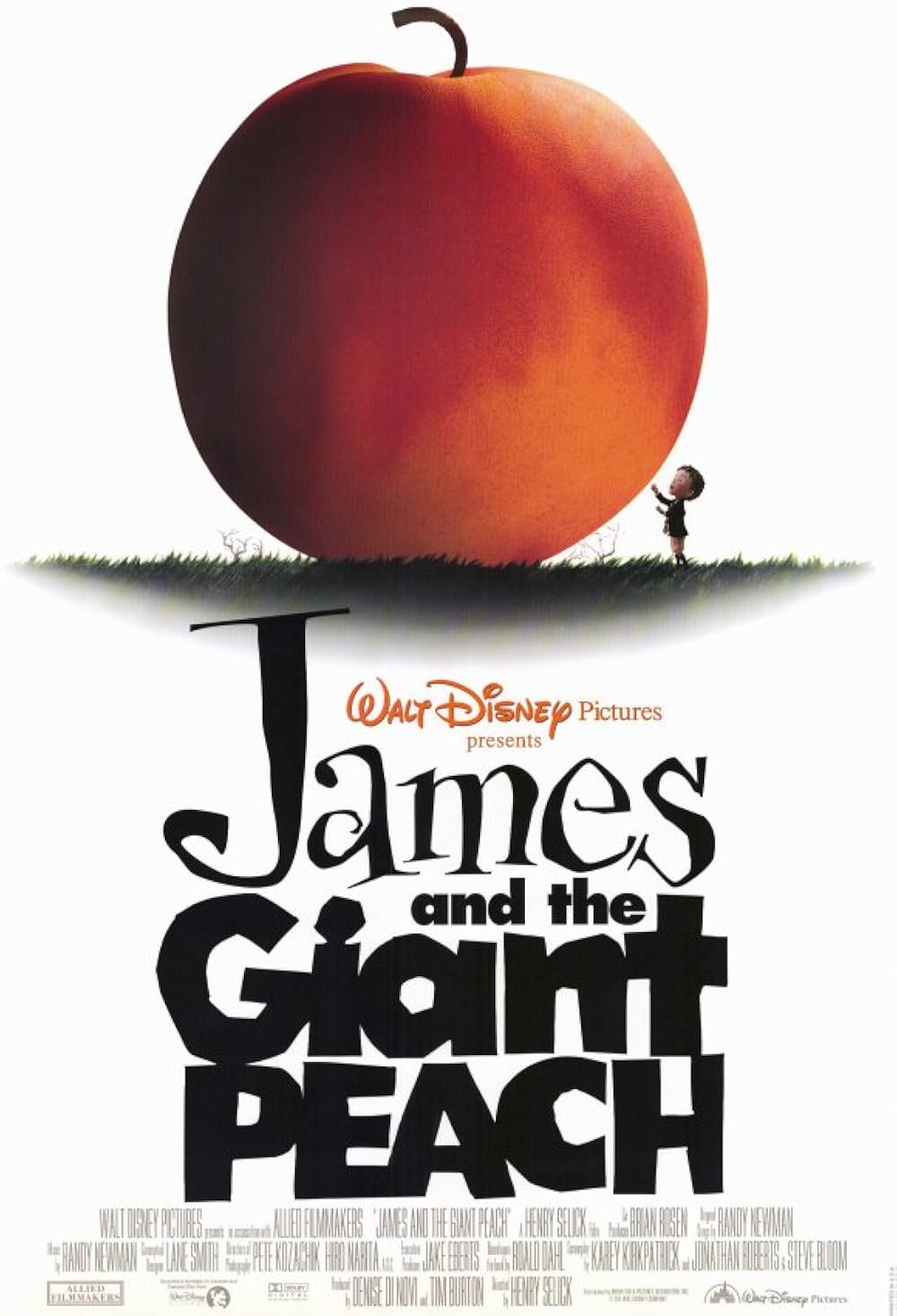
What Selick and Burton have done with it, however, brings stop-motion to a new plateau. The movements of their characters are so fluid, compared with the slight jerkiness of older stop-motion, that I wonder if computers have been used to smooth out some of the motion. If not, then their achievement is even more amazing. All of the creatures, especially the colorful insects that share James’ journey, are brought to vivid life, and the fact that we can see realistic textures–like the cloth in some of the costumes–gives the illusion an eerie quality halfway between reality and invention.
As for the movie, based on a familiar children’s book by Roald Dahl, it will, I think, entertain kids for whom stop-motion animation is the last thing they’re thinking about. The peach, carried by seagulls, drifts far north to the Arctic Circle, where there is a frightening underwater adventure on a sunken pirate ship (the villains torture the centipede on the rack). But James finally arrives at his destination in New York, where still more adventures await him(and the rhino attacks again). Oh, and there are some songs.Wallace and Gromit: The Curse of the Were-Rabbit
Wallace and Gromit are arguably the two most delightful characters in the history of animation. Between the previous sentence and this one I paused thoughtfully and stared into space and thought of all of the other animated characters I have ever met, and I gave full points to Bugs Bunny and high marks to Little Nemo and a fond nod to Goofy, and returned to the page convinced that, yes, Wallace and Gromit are in a category of their own. To know them is to enter a universe of boundless optimism, in which two creatures who are perfectly suited to each other venture out every morning to make the world into a safer place for the gentle, the good and the funny. Wallace is an inventor. Gromit is a dog, although the traditional human-dog relationship is reversed in that Gromit usually has to clean up Wallace’s messes. No, not those kinds of messes. They’re not that kind of movie. In three short subjects and now in their first feature, Wallace sails out bravely do to great but reckless deeds, and Gromit takes the role of adult guardian.
info:
Director: Nick Park, Steve BoxStarring: Peter Sallis
Helena Bonham Carter
Peter Kay
Release date:
October 5, 2005
In “Wallace & Gromit: The Curse of the Were-Rabbit,” they face their greatest challenge. Lady Tottington is holding her family’s 517th annual Giant Vegetable Fete, and all the gardeners for miles around are lovingly caressing their gigantic melons and zucchinis and carrots and such, and Wallace and Gromit are responsible for security, which means keeping rabbits out of the garden patches. Their company is named Anti-Pesto. Their methods are humane. They do not shoot or poison the bunnies. Instead, Wallace has devised another of his ingenious inventions, the Bun-Vac, which sucks the rabbits out of their holes and into a giant holding tube, so that they can be housed in comfort at Anti-Pesto headquarters, and feast on medium and small vegetables. Their tactics perfectly suit Lady Tottington’s humane convictions.
They have a rival, the sniveling barbarian Lord Victor Quartermaine, a gun nut with a toupee heaped on his head like a mess of the sort Gromit never has to clean up. Lord Victor dreams of marrying Lady Tottington and treating himself to the luxuries of her ancestral wealth, and that involves discrediting and sabotaging Anti-Pesto and all that it stands for. Thus is launched the affair of the Were-Rabbit, a gigantic beast (with a red polka dot tie) that terrorizes the neighborhood and inspires the Reverend Hedges to cry out, “For our sins a hideous creature has been sent to punish us.” I dare not reveal various secrets involving the Were-Rabbit, so I will skip ahead, or sideways, to consider Wallace’s new invention, the Mind-o-Matic, which is intended to brainwash rabbits and convince them they do not like vegetables. That this device malfunctions goes without saying, and that Gromit has to fly to the rescue is a given.
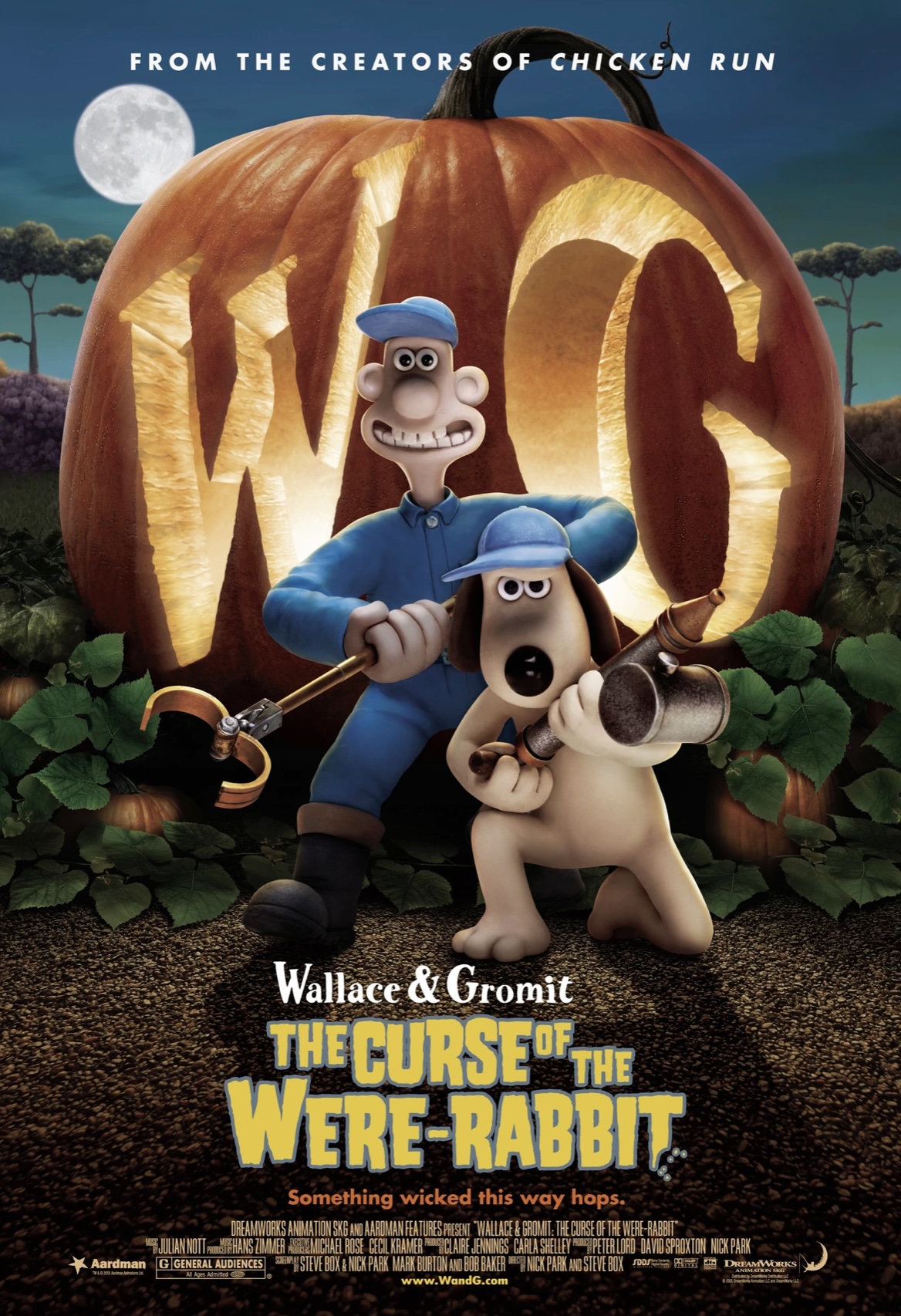
Wallace and Gromit are the inventions of a British animator named Nick Park, who co-directs this time with Steve Box. In an era of high-tech CGI, Park uses the beloved traditional form of stop-motion animation. He constructs his characters and sets out of Plasticine, a brand of modeling clay, and makes minute adjustments to them between every frame, giving the impression not only of movement but of exuberant life and color bursting from every frame. (As a nod to technology, just a little CGI is incorporated for certain scenes that would be hard to do in Plasticine, as when the vacuumed bunnies are in free-fall). Remarkably, given the current realities of animation, “Wallace & Gromit: The Curse of the Were-Rabbit” is the second stop-motion animated film in two weeks, after Tim Burton’s “Corpse Bride.” Both of these films are wonderful, but Wallace and Gromit have the additional quality of being lovable beyond all measure, inhabiting a world of British eccentricity that produces dialogue such as: “This is worse than 1972, when there were slugs the size of pigs.”
Coraline
The director of “Coraline” has suggested it is for brave children of any age. That’s putting it mildly. This is nightmare fodder for children, however brave, under a certain age. I know kids are exposed to all sorts of horror films via video, but “Coraline” is disturbing not for gory images but for the story it tells. That’s rare in itself: Lots of movies are good at severing limbs, but few at telling tales that can grab us down inside where it’s dark and scary. Even more rare is that Coraline Jones (Dakota Fanning) is not a nice little girl. She’s unpleasant, complains, has an attitude and makes friends reluctantly. Nor does she meet sweet and colorful new pals in her adventure, which involves the substitution of her parents by ominous doubles with buttons sewn over their eyes. She is threatened with being trapped in their alternate world, which is reached by an alarming tunnel behind a painted-over doorway in her own.
info:
Director: Henry SelickStarring: Dakota Fanning
Teri Hatcher
Keith David
Release date:
Febuary 6, 2009
Not that Coraline’s own parents are all that great. They’re busy, distracted, bickering and always hunched over their computers. They hardly hear her when she talks. That’s why she recklessly enters the tunnel and finds her Other Mother and Other Father waiting with roast chicken and a forced cheerfulness. All she needs to stay there is to have buttons sewn into her own eye sockets. “Coraline” is the new film by Henry Selick, who made “The Nightmare Before Christmas” (1993) and again combines his mastery of stop-motion and other animation with 3-D. The 3-D creates a gloomier image (take off the glasses and the screen is bright), but then this is a gloomy film with weird characters doing nasty things. I’ve heard of eating chocolate-covered insects, but not when they’re alive.
The ideal audience for this film would be admirers of film art itself, assuming such people exist. Selick creates an entirely original look and feel, uses the freedom of animation to elongate his characters into skeletal spectres looming over poor Coraline. Her new friend, Wybie (Robert Bailey Jr.), is a young hunchback whose full name is Wyborn, and it doesn’t take Coraline long to wonder why his parents named him that. The Other Mother and Father (voices of Teri Hatcher and John Hodgman, who are also Father and Mother) essentially want to steal Coraline from her real but distracted parents and turn her into some kind of a Stepford daughter. Their house, which looks like Coraline’s own, has two old ladies (Jennifer Saunders and Dawn French) in the basement, boarders who seem in retirement from subtly hinted careers in the adult-entertainment industry. The upstairs boarder is Mr. Bobinsky (Ian McShane), a sometime vaudevillian who has a troupe of trained mice. One of the rooms of the house has insects bigger than Coraline who act as living furniture. It’s more or less impossible for me, anyway, to be scared by 3-D animation. The process always seems to be signaling, “I’m a process!” I think it’s harder to get involved in a story when the process doesn’t become invisible. I hear from parents who say, “My kids didn’t even notice the 3-D!” In that case, why have it in the first place?
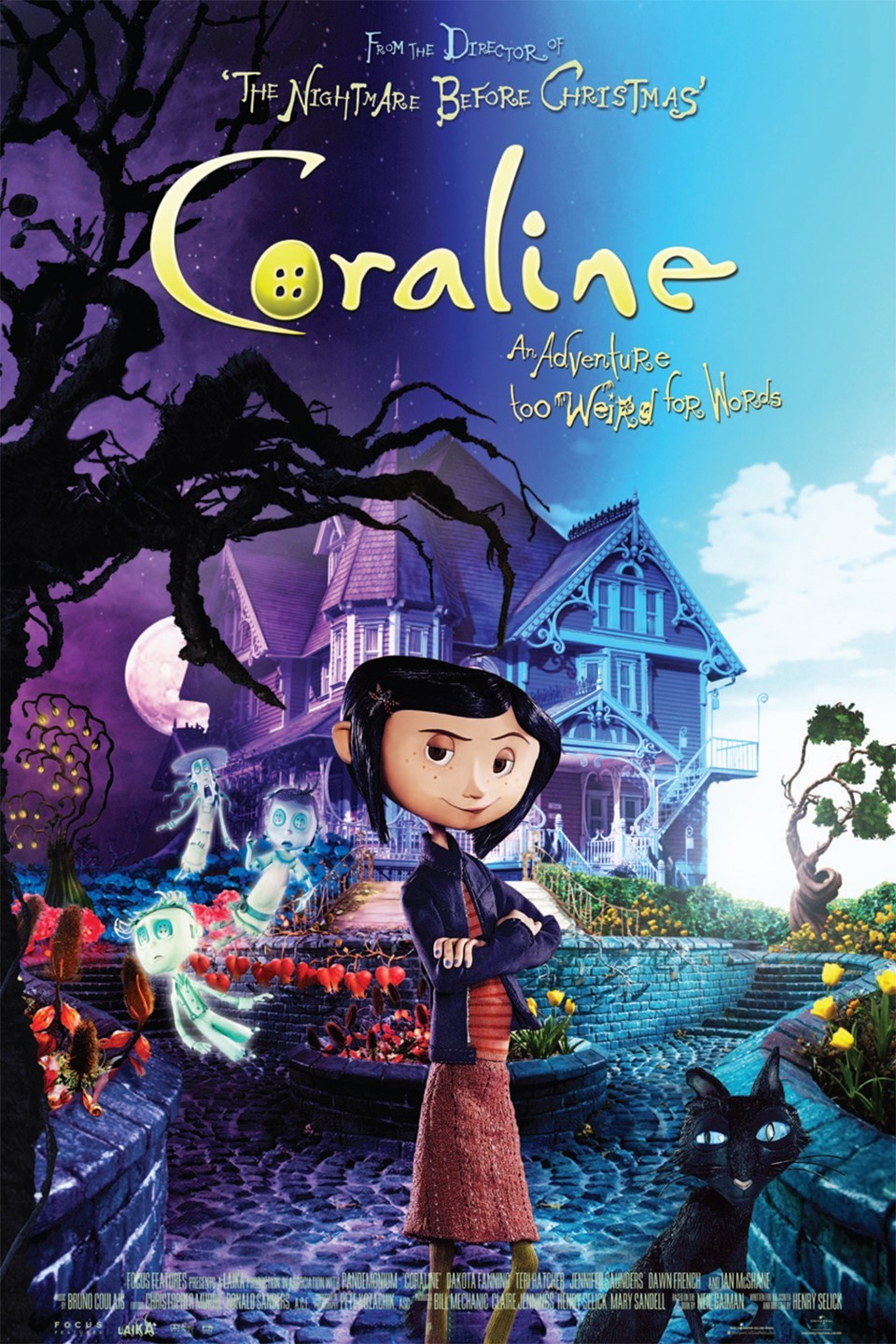
Kids who will be scared by the story may not all be happy to attend, 3-D or not. I suspect a lot of lovers of the film will include admirers of Neil Gaiman, whose Hugo Award-winning novel inspired Selick’s screenplay. Gaiman is a titan of graphic novels, and there’s a nice irony that one of his written books has been adapted as animation. I admire the film mostly because it is good to look at. Selick is as unconventional in his imagery as Gaiman is in his writing, and this is a movie for people who know and care about drawing, caricature, grotesquerie and the far shores of storytelling. In short, you might care little about a fantasy, little indeed about this story, and still admire the artistry of it all, including an insidious score by Bruno Coulais, which doesn’t pound at us like many horror scores, but gets under our psychic fingernails. Credit is due to those who backed this film.